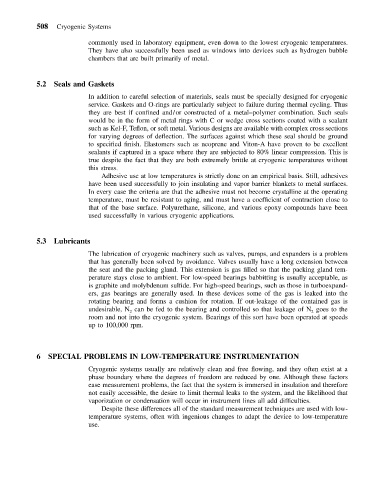Page 519 - Mechanical Engineers' Handbook (Volume 4)
P. 519
508 Cryogenic Systems
commonly used in laboratory equipment, even down to the lowest cryogenic temperatures.
They have also successfully been used as windows into devices such as hydrogen bubble
chambers that are built primarily of metal.
5.2 Seals and Gaskets
In addition to careful selection of materials, seals must be specially designed for cryogenic
service. Gaskets and O-rings are particularly subject to failure during thermal cycling. Thus
they are best if confined and/or constructed of a metal–polymer combination. Such seals
would be in the form of metal rings with C or wedge cross sections coated with a sealant
such as Kel-F, Teflon, or soft metal. Various designs are available with complex cross sections
for varying degrees of deflection. The surfaces against which these seal should be ground
to specified finish. Elastomers such as neoprene and Viton-A have proven to be excellent
sealants if captured in a space where they are subjected to 80% linear compression. This is
true despite the fact that they are both extremely brittle at cryogenic temperatures without
this stress.
Adhesive use at low temperatures is strictly done on an empirical basis. Still, adhesives
have been used successfully to join insulating and vapor barrier blankets to metal surfaces.
In every case the criteria are that the adhesive must not become crystalline at the operating
temperature, must be resistant to aging, and must have a coefficient of contraction close to
that of the base surface. Polyurethane, silicone, and various epoxy compounds have been
used successfully in various cryogenic applications.
5.3 Lubricants
The lubrication of cryogenic machinery such as valves, pumps, and expanders is a problem
that has generally been solved by avoidance. Valves usually have a long extension between
the seat and the packing gland. This extension is gas filled so that the packing gland tem-
perature stays close to ambient. For low-speed bearings babbitting is usually acceptable, as
is graphite and molybdenum sulfide. For high-speed bearings, such as those in turboexpand-
ers, gas bearings are generally used. In these devices some of the gas is leaked into the
rotating bearing and forms a cushion for rotation. If out-leakage of the contained gas is
undesirable, N can be fed to the bearing and controlled so that leakage of N goes to the
2
2
room and not into the cryogenic system. Bearings of this sort have been operated at speeds
up to 100,000 rpm.
6 SPECIAL PROBLEMS IN LOW-TEMPERATURE INSTRUMENTATION
Cryogenic systems usually are relatively clean and free flowing, and they often exist at a
phase boundary where the degrees of freedom are reduced by one. Although these factors
ease measurement problems, the fact that the system is immersed in insulation and therefore
not easily accessible, the desire to limit thermal leaks to the system, and the likelihood that
vaporization or condensation will occur in instrument lines all add difficulties.
Despite these differences all of the standard measurement techniques are used with low-
temperature systems, often with ingenious changes to adapt the device to low-temperature
use.

